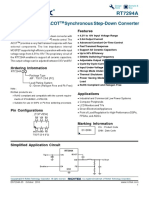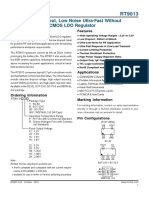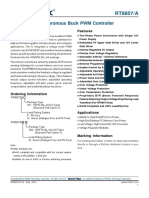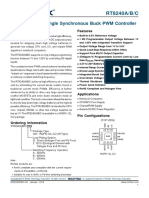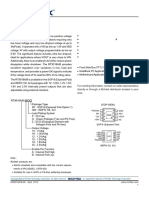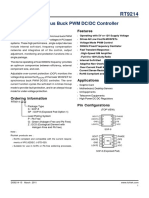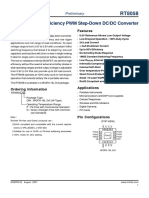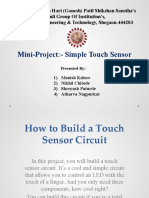RT7278
RT7278
Uploaded by
RAUL E DIAZ BASULTOCopyright:
Available Formats
RT7278
RT7278
Uploaded by
RAUL E DIAZ BASULTOCopyright
Available Formats
Share this document
Did you find this document useful?
Is this content inappropriate?
Copyright:
Available Formats
RT7278
RT7278
Uploaded by
RAUL E DIAZ BASULTOCopyright:
Available Formats
®
RT7278
3A, 18V, 700kHz ACOTTM Synchronous Step-Down Converter
General Description Features
The RT7278 is a synchronous DC/DC step-down converter z ACOTTM Mode Enables Fast Transient Response
with Advanced Constant On-Time (ACOTTM) mode control. z 4.5V to 18V Input Voltage Range
It achieves high power density to deliver up to 3A output z 3A Output Current
current from a 4.5V to 18V input supply. The proprietary z 60mΩΩ Internal Low Site N-MOSFET
ACOTTM mode offers an optimal transient response over a z Advanced Constant On-Time Control
wide range of loads and all kinds of ceramic capacitors, z Support All Ceramic Capacitors
which allows the device to adopt very low ESR output z Up to 95% Efficiency
capacitors for ensuring performance stabilization. In z 700kHz Switching Frequency
addition, RT7278 keeps an excellent constant switching z Adjustable Output Voltage from 0.765V to 8V
frequency under line and load variation and the integrated z Adjustable Soft-Start
synchronous power switches with the ACOTTM mode z Cycle-by-Cycle Current Limit
operation provides high efficiency in whole output current z Input Under Voltage Lockout
load range. Cycle-by-cycle current limit provides an z Thermal Shutdown
accurate protection by a valley detection of low side z RoHS Compliant and Halogen Free
MOSFET and external soft-start setting eliminates input
current surge during startup. Protection functions also Applications
include output under voltage protection, output over voltage z Industrial and Commercial Low Power Systems
protection, and thermal shutdown. z Computer Peripherals
z LCD Monitors and TVs
Marking Information z Green Electronics/Appliances
RT7278GSP : Product Number z Point of Load Regulation for High-Performance DSPs,
RT7278 YMDNN : Date Code FPGAs, and ASICs
GSPYMDNN
Simplified Application Circuit
RT7278 L1
VIN VIN SW VOUT
C1 C2 C6 C7
BOOT C3 R1
Enable EN FB
SS PVCC VPVCC R2
C5 C4
GND
Copyright © 2013 Richtek Technology Corporation. All rights reserved. is a registered trademark of Richtek Technology Corporation.
DS7278-00 January 2013 www.richtek.com
1
Free Datasheet http://www.datasheet4u.com/
RT7278
Ordering Information Pin Configurations
RT7278 (TOP VIEW)
Package Type EN 8 VIN
SP : SOP-8 (Exposed Pad-Option 2) FB 2 7 BOOT
GND
Lead Plating System PVCC 3 6 SW
9
G : Green (Halogen Free and Pb Free) SS 4 5 GND
Note :
SOP-8 (Exposed Pad)
Richtek products are :
` RoHS compliant and compatible with the current require-
ments of IPC/JEDEC J-STD-020.
` Suitable for use in SnPb or Pb-free soldering processes.
Functional Pin Description
Pin No. Pin Name Pin Function
Enable Control Input. A logic-high enables the converter; a logic-low forces
1 EN
the IC into shutdown mode reducing the supply current to less than 10μA.
Feedback Voltage Input. It is used to regulate the output of the converter to a
2 FB set value via an external resistive voltage divider. The feedback threshold
voltage is 0.765V typically.
Regulator Output for Internal Circuit. Connect a 1μF capacitor to GND to
3 PVCC
stabilize output voltage.
Soft-Start Time Setting. SS controls the soft-start period. Connect a capacitor
4 SS from SS to GND to set the soft-start period. A 3.9nF capacitor sets the
soft-start period of VOUT to 2.6ms.
5, 9 Ground. The Exposed pad should be soldered to a large PCB and connected
GND
(Exposed Pad) to GND for maximum thermal dissipation.
6 SW Switch Node. Connect this pin to an external L-C filter.
Bootstrap Supply for High Side Gate Driver. Connect a 0.1μF or greater
7 BOOT
ceramic capacitor from BOOT to SW pins.
Power Input. The input voltage range is from 4.5V to 18V. Must bypass with a
8 VIN
suitably large ( ≥10μF x 2) ceramic capacitor.
Copyright © 2013 Richtek Technology Corporation. All rights reserved. is a registered trademark of Richtek Technology Corporation.
www.richtek.com DS7278-00 January 2013
2
Free Datasheet http://www.datasheet4u.com/
RT7278
Function Block Diagram
PVCC BOOT
Internal
VIN
Regulator
PVCC Over Current PVCC
Protection
VIBIAS VREF
UGATE
Switch SW
Driver
Controller
PVCC Ripple LGATE
Gen. GND
2µA SW
+
SS
- -
FB
FB
Comparator
On-Time EN
EN
Operation
In normal operation, the high side N-MOSFET is turned Enable
on when the FB Comparator sets the Switch Controller, Activate internal regulator once EN input level is higher
and it is turned off when On-Time Controller resets the than the target level. Force IC to enter shutdown mode
Switch Controller. While the high side N-MOSFET is turned when the EN input level is lower than 0.4V
off, the low side N-MOSFET is turned on and waits for the
FB Comparator to set the beginning of next cycle. Internal Regulator
The FB Comparator sets the Switch Controller by Provide internal power for logic control and switch gate
comparing the feedback signal (FB) from output voltage drivers.
with the internal 0.765V reference. When load transient
On-Time Controller
induces VOUT drop, the FB voltage will be less than its
Control on-time according to VIN and SW to obtain
threshold voltage. This means that the high side N-MOSFET
constant switching frequency.
will turn on again immediately after minimum off-time
expired. The switching frequency will vary during the
transient period thus can provide a very fast transient
response. After the load transient finished, the RT7278
will be back to steady state with a constant switching
frequency.
Copyright © 2013 Richtek Technology Corporation. All rights reserved. is a registered trademark of Richtek Technology Corporation.
DS7278-00 January 2013 www.richtek.com
3
Free Datasheet http://www.datasheet4u.com/
RT7278
Absolute Maximum Ratings (Note 1)
z Supply Voltage, VIN ----------------------------------------------------------------------------------------------- −0.3V to 21V
z Switch Voltage, SW ----------------------------------------------------------------------------------------------- −0.8V to (VIN + 0.3V)
<10ns ----------------------------------------------------------------------------------------------------------------- −5V to 25V
z BOOT to SW, PVCC ---------------------------------------------------------------------------------------------- −0.3V to 6V
z Other Pins Voltage ------------------------------------------------------------------------------------------------- −0.3V to 21V
z Power Dissipation, PD @ TA = 25°C
SOP-8 (Exposed Pad) -------------------------------------------------------------------------------------------- 2.041W
z Package Thermal Resistance (Note 2)
SOP-8 (Exposed Pad), θJA --------------------------------------------------------------------------------------- 49°C/W
SOP-8 (Exposed Pad), θJC -------------------------------------------------------------------------------------- 15°C/W
z Junction Temperature Range ------------------------------------------------------------------------------------- 150°C
z Lead Temperature (Soldering, 10 sec.) ------------------------------------------------------------------------ 260°C
z Storage Temperature Range ------------------------------------------------------------------------------------- −65°C to 150°C
z ESD Susceptibility (Note 3)
HBM (Human Body Model) --------------------------------------------------------------------------------------- 2kV
Recommended Operating Conditions (Note 4)
z Supply Voltage, VIN ----------------------------------------------------------------------------------------------- 4.5V to 18V
z Junction Temperature Range ------------------------------------------------------------------------------------- −40°C to 125°C
z Ambient Temperature Range ------------------------------------------------------------------------------------- −40°C to 85°C
Electrical Characteristics
(VIN = 12V, TA = 25°C, unless otherwise specified)
Parameter Symbol Test Conditions Min Typ Max Unit
Supply Current
Shutdown Current ISHDN VEN = 0V -- 1.5 10 μA
Quiescent Current IQ VEN = 3V, VFB = 1V -- 0.7 -- mA
Logic Threshold
Logic-High 2 -- 18
EN Input Voltage V
Logic-Low -- -- 0.4
VFB Voltage and Discharge Resistance
Feedback Threshold Voltage VFB 4.5V ≤ VIN ≤ 18V 0.757 0.765 0.773 V
Feedback Input Current IFB VFB = 0.8V −0.1 0 0.1 μA
VPVCC Output
VPVCC Output Voltage VPVCC 6V ≤ VIN ≤ 18V, 0 < IPVCC < 5mA 4.7 5.1 5.5 V
Line Regulation 6V ≤ VIN ≤ 18V, IPVCC = 5mA -- -- 20 mV
Load Regulation 0 < IPVCC < 5mA -- -- 100 mV
Output Current IPVCC VIN = 6V, VPVCC = 4V -- 110 -- mA
Copyright © 2013 Richtek Technology Corporation. All rights reserved. is a registered trademark of Richtek Technology Corporation.
www.richtek.com DS7278-00 January 2013
4
Free Datasheet http://www.datasheet4u.com/
RT7278
Parameter Symbol Test Conditions Min Typ Max Unit
RDS(ON)
Switch On High-Side RDS(ON)_H -- 90 --
mΩ
Resistance Low-Side RDS(ON)_L -- 60 --
Current Limit
Current Limit ILIM 3.5 4.1 5.7 A
Thermal Shutdown
Thermal Shutdown Threshold TSD -- 150 -- °C
Thermal Shutdown Hysteresis ΔTSD -- 20 -- °C
On-Time Timer Control
On-Time tON VIN = 12V, VOUT = 1.05V -- 145 -- ns
Minimum On-Time tON(MIN) -- 60 -- ns
Minimum Off-Time tOFF(MIN) -- 230 -- ns
Soft-Start
SS Charge Current VSS = 0V 1.4 2 2.6 μA
SS Discharge Current VSS = 0.5V 0.05 0.1 -- mA
UVLO
UVLO Threshold VIN Rising to Wake up VPVCC 3.55 3.85 4.15
V
Hysteresis -- 0.3 --
Note 1. Stresses beyond those listed “Absolute Maximum Ratings” may cause permanent damage to the device. These are
stress ratings only, and functional operation of the device at these or any other conditions beyond those indicated in
the operational sections of the specifications is not implied. Exposure to absolute maximum rating conditions may
affect device reliability.
Note 2. θJA is measured at TA = 25°C on a high effective thermal conductivity four-layer test board per JEDEC 51-7. θJC is
measured at the exposed pad of the package. The PCB copper area of exposed pad is 70mm2.
Note 3. Devices are ESD sensitive. Handling precaution is recommended.
Note 4. The device is not guaranteed to function outside its operating conditions.
Copyright © 2013 Richtek Technology Corporation. All rights reserved. is a registered trademark of Richtek Technology Corporation.
DS7278-00 January 2013 www.richtek.com
5
Free Datasheet http://www.datasheet4u.com/
RT7278
Typical Application Circuit
L1
1.4µH
8 RT7278 6 VOUT
VIN VIN SW 1.05V/3A
C1 C2 C6 C7
10µF x 2 0.1µF 0.1µF C3 R1 22µF x 2
1 7 8.25k
Enable EN BOOT
5, 9 (Exposed Pad) 2
GND FB
R2
4 SS 3 22.1k
PVCC VPVCC
C5
3.9nF C4
1µF
Table 1. Suggested Component Values
VOUT (V) R1 (kΩ) R2 (kΩ) C3 (pF) L1 (μH) C7 (μF)
1 6.81 22.1 -- 1.4 22 to 68
1.05 8.25 22.1 -- 1.4 22 to 68
1.2 12.7 22.1 -- 1.4 22 to 68
1.8 30.1 22.1 5 to 22 2 22 to 68
2.5 49.9 22.1 5 to 22 2 22 to 68
3.3 73.2 22.1 5 to 22 2 22 to 68
5 124 22.1 5 to 22 3.3 22 to 68
7 180 22.1 5 to 22 3.3 22 to 68
Copyright © 2013 Richtek Technology Corporation. All rights reserved. is a registered trademark of Richtek Technology Corporation.
www.richtek.com DS7278-00 January 2013
6
Free Datasheet http://www.datasheet4u.com/
RT7278
Typical Operating Characteristics
Efficiency vs. Load Current Output Voltage vs. Input Voltage
100 1.20
90 1.15
80
1.10
Output Voltage (V)
70 VIN = 5V
Efficiency (%)
VIN = 12V 1.05
60
VIN = 17V
50 1.00
40 0.95
30
0.90
20
0.85
10
VOUT = 1.05V VIN = 4.5V to 17V, VOUT = 1.05V
0 0.80
0.001 0.01 0.1 1 10 4 5 6 7 8 9 10 11 12 13 14 15 16 17
Load Current (A) Input Voltage (V)
Output Voltage vs. Temperature Output Voltage vs. Output Current
1.10 1.10
1.09
1.08 1.08
Output Voltage (V)
Output Voltage (V)
1.07
1.06 1.06
1.05
1.04 1.04 VIN = 17V
1.03 VIN = 12V
VIN = 5V
1.02 1.02
1.01
VIN = 12V, VOUT = 1.05V, IOUT = 0A VOUT = 1.05V
1.00 1.00
-50 -25 0 25 50 75 100 125 0.0 0.3 0.6 0.9 1.2 1.5 1.8 2.1 2.4 2.7 3.0
Temperature (°C) Output Current (A)
Switching Frequency vs. Input Voltage Switching Frequency vs. Temperature
750 750
740 740
Switching Frequency (kHz)1
Switching Frequency (kHz)1
730 730
720 720
710 710
700 700
690 690
680 680
670 670
660 660
VOUT = 1.05V, IOUT = 0.6A VOUT = 1.05V, IOUT = 0.6A
650 650
4 6 8 10 12 14 16 18 -50 -25 0 25 50 75 100 125
Input Voltage (V) Temperature (C)
Copyright © 2013 Richtek Technology Corporation. All rights reserved. is a registered trademark of Richtek Technology Corporation.
DS7278-00 January 2013 www.richtek.com
7
Free Datasheet http://www.datasheet4u.com/
RT7278
Current Limit vs. Temperature Currrent Limit vs. Input Voltage
6.0 6.0
5.6 5.6
Currrent Limit (A)
Current Limit (A)
5.2 5.2
4.8 4.8
4.4 4.4
VIN = 12V, VOUT = 1.05V VOUT = 1.05V
4.0 4.0
-50 -25 0 25 50 75 100 125 4 6 8 10 12 14 16 18
Temperature (°C) Input Voltage (V)
Load Transient Response Load Transient Response
VOUT VOUT
(50mV/Div) (20mV/Div)
IOUT IOUT
(2A/Div) (2A/Div)
VIN = 12V, VOUT = 1.05V, IOUT = 10mA to 3A VIN = 12V, VOUT = 1.05V, IOUT = 1A to 3A
Time (250μs/Div) Time (100μs/Div)
Output Ripple Voltage Output Ripple Voltage
VOUT VOUT
(10mV/Div) (10mV/Div)
VLX VLX
(10V/Div) (10V/Div)
VIN = 12V, VOUT = 1.05V, IOUT = 3A VIN = 12V, VOUT = 5V, IOUT = 3A
Time (1μs/Div) Time (1μs/Div)
Copyright © 2013 Richtek Technology Corporation. All rights reserved. is a registered trademark of Richtek Technology Corporation.
www.richtek.com DS7278-00 January 2013
8
Free Datasheet http://www.datasheet4u.com/
RT7278
Power On from VIN Power Off from VIN
VIN VIN
(5V/Div) (5V/Div)
VOUT VOUT
(1V/Div) (1V/Div)
IOUT IOUT
(2A/Div) (2A/Div)
VIN = 12V, VOUT = 1.05V, IOUT = 3A VIN = 12V, VOUT = 1.05V, IOUT = 3A
Time (5ms/Div) Time (10ms/Div)
Power On from EN Power Off from EN
VEN VEN
(2V/Div) (2V/Div)
VOUT VOUT
(1V/Div) (1V/Div)
IOUT IOUT
(2A/Div) (2A/Div)
VIN = 12V, VOUT = 1.05V, IOUT = 3A VIN = 12V, VOUT = 1.05V, IOUT = 3A
Time (1ms/Div) Time (10μs/Div)
EN Current vs. EN Voltage
10
9
8
7
EN Current (μA)
6
5
4
3
2
1
VIN = 17V
0
0 2 4 6 8 10 12 14 16 18
EN Voltage (V)
Copyright © 2013 Richtek Technology Corporation. All rights reserved. is a registered trademark of Richtek Technology Corporation.
DS7278-00 January 2013 www.richtek.com
9
Free Datasheet http://www.datasheet4u.com/
RT7278
Application Information
The RT7278 is a synchronous high voltage Buck converter device again. For external timing control, the EN pin can
that can support the input voltage range from 4.5V to 18V also be externally pulled high by adding a REN resistor
and the output current up to 3A. It adopts ACOTTM mode and CEN capacitor from the VIN pin (see Figure 1).
control to provide a very fast transient response with few
EN
external compensation components. REN
VIN EN
PWM Operation RT7278
CEN
It is suitable for low external component count GND
configuration with appropriate amount of Equivalent Series
Figure 1. External Timing Control
Resistance (ESR) capacitors at the output. The output
ripple valley voltage is monitored at a feedback point An external MOSFET can be added to implement digital
voltage. The synchronous high side MOSFET is turned control on the EN pin when the EN pin input voltage is
on at the beginning of each cycle. After the internal on- lower than 2V, as shown in Figure 2. In this case, a 100kΩ
time timer expires, the MOSFET is turned off. The pulse pull-up resistor, REN, is connected between VIN and the
width of this on-time is determined by the converter's input EN pin. MOSFET Q1 will be under logic control to pull
and output voltages to keep the frequency fairly constant down the EN pin.
over the entire input voltage range.
REN
100k
Advanced Constant On-Time Control VIN EN
The RT7278 has a unique circuit which sets the on-time EN Q1 RT7278
by monitoring the input voltage and SW signal. The circuit
GND
ensures the switching frequency operating at 700kHz over
input voltage range and loading range.
Figure 2. Digital Enable Control Circuit
Soft-Start To prevent enabling circuit when VIN is smaller than the
The RT7278 contains an external soft-start clamp that VOUT target value, a resistive voltage divider can be placed
gradually raises the output voltage. The soft-start timing between the input voltage and ground and connected to
can be programmed by the external capacitor between the EN pin to adjust IC lockout threshold, as shown in
SS pin and GND. The chip provides a 2μA charge current Figure 3. For example, if an 8V output voltage is regulated
for the external capacitor. If a 3.9nF capacitor is used, from a 12V input voltage, the resistor REN2 can be selected
the soft-start will be 2.6ms (typ.). The available capacitance to set input lockout threshold larger than 8V.
range is from 2.7nF to 220nF.
REN1
C5 (nF) × 1.365 VIN EN
t SS (ms) =
ISS (μ A) REN2 RT7278
GND
Chip Enable Operation
The EN pin is the chip enable input. Pulling the EN pin
Figure 3. Resistor Divider for Lockout Threshold Setting
low (<0.4V) will shut down the device. During shutdown
mode, the RT7278's quiescent current drops to lower than
10μA. Driving the EN pin high (>2V, <18V) will turn on the
Copyright © 2013 Richtek Technology Corporation. All rights reserved. is a registered trademark of Richtek Technology Corporation.
www.richtek.com DS7278-00 January 2013
10
Free Datasheet http://www.datasheet4u.com/
RT7278
Output Voltage Setting inductor to achieve this goal. For the ripple current
The resistive divider allows the FB pin to sense the output selection, the value of ΔIL = 0.2(IMAX) will be a reasonable
voltage as shown in Figure 4. starting point. The largest ripple current occurs at the
VOUT highest VIN. To guarantee that the ripple current stays
below the specified maximum, the inductor value should
R1 be chosen according to the following equation :
FB
⎡ VOUT ⎤ ⎡ VOUT ⎤
RT7278 R2 L =⎢
f × Δ I ⎥ × ⎢1 − VIN(MAX) ⎥
⎣ L(MAX) ⎦ ⎣ ⎦
GND
Figure 4. Output Voltage Setting Input and Output Capacitors Selection
The input capacitance, C IN, is needed to filter the
The output voltage is set by an external resistive divider
trapezoidal current at the Source of the high side MOSFET.
according to the following equation. It is recommended to
A low ESR input capacitor with larger ripple current rating
use 1% tolerance or better divider resistors.
should be used for the maximum RMS current. The RMS
R1 current is given by :
VOUT = 0.765 × (1+ )
R2
V VIN
IRMS = IOUT(MAX) OUT −1
Under Voltage Lockout Protection VIN VOUT
The RT7278 has Under Voltage Lockout Protection (UVLO) This formula has a maximum at VIN = 2VOUT, where
that monitors the voltage of PVCC pin. When the VPVCC IRMS = IOUT / 2. This simple worst-case condition is
voltage is lower than UVLO threshold voltage, the RT7278 commonly used for design because even significant
will be turned off in this state. This is non-latch protection. deviations do not offer much relief.
Choose a capacitor rated at a higher temperature than
Over Temperature Protection
required. Several capacitors may also be paralleled to
The RT7278 equips an Over Temperature Protection (OTP) meet size or height requirements in the design. For the
circuitry to prevent overheating due to excessive power input capacitor, two 10μF and 0.1μF low ESR ceramic
dissipation. The OTP will shut down switching operation capacitors are recommended.
when junction temperature exceeds 150°C. Once the
The selection of COUT is determined by the required ESR
junction temperature cools down by approximately 20°C
to minimize voltage ripple.
the main converter will resume operation. To keep operating
at maximum, the junction temperature should be prevented Moreover, the amount of bulk capacitance is also a key
from rising above 150°C. for COUT selection to ensure that the control loop is stable.
The output ripple, ΔVOUT, is determined by :
Inductor Selection
ΔVOUT ≤ ΔIL ⎡⎢ESR + 1 ⎤
The inductor value and operating frequency determine the ⎣ 8fCOUT ⎦⎥
ripple current according to a specific input and an output The output ripple will be highest at the maximum input
voltage. The ripple current ΔIL increases with higher VIN voltage since ΔIL increases with input voltage. Multiple
and decreases with higher inductance. capacitors placed in parallel may need to meet the ESR
ΔIL = ⎡⎢ OUT ⎤⎥ × ⎡⎢1− OUT ⎤⎥
V V and RMS current handling requirements.
⎣ f × L ⎦ ⎣ VIN ⎦
Higher values, lower cost ceramic capacitors are now
Having a lower ripple current reduces not only the ESR becoming available in smaller case sizes. Their high ripple
losses in the output capacitors but also the output voltage current, high voltage rating and low ESR make them ideal
ripple. High frequency with small ripple current can achieve for switching regulator applications. However, care must
highest efficiency operation. However, it requires a large be taken when these capacitors are used at input and
Copyright © 2013 Richtek Technology Corporation. All rights reserved. is a registered trademark of Richtek Technology Corporation.
DS7278-00 January 2013 www.richtek.com
11
Free Datasheet http://www.datasheet4u.com/
RT7278
output. When a ceramic capacitor is used at the input Thermal Considerations
and the power is supplied by a wall adapter through long For continuous operation, do not exceed absolute
wires, a load step at the output can induce ringing at the maximum junction temperature. The maximum power
input, VIN. A sudden inrush of current through the long dissipation depends on the thermal resistance of the IC
wires can potentially cause a voltage spike at VIN large package, PCB layout, rate of surrounding airflow, and
enough to damage the part. difference between junction and ambient temperature. The
maximum power dissipation can be calculated by the
External Bootstrap Diode
following formula :
Connect a 0.1μF low ESR ceramic capacitor between the
PD(MAX) = (TJ(MAX) − TA) / θJA
BOOT and SW pins. This capacitor provides the gate driver
voltage for the high side MOSFET. It is recommended to where TJ(MAX) is the maximum junction temperature, TA is
add an external bootstrap diode between an external 5V the ambient temperature, and θJA is the junction to ambient
and the BOOT pin for efficiency improvement when input thermal resistance.
voltage is lower than 5.5V or duty ratio is higher than 65%. For recommended operating condition specifications, the
The bootstrap diode can be a low cost one, such as maximum junction temperature is 125°C. The junction to
1N4148 or BAT54. The external 5V can be a 5V fixed ambient thermal resistance, θJA, is layout dependent. For
input from system or a 5V output of the RT7278. Note SOP-8 (Exposed Pad) package, the thermal resistance,
that the external boot voltage must be lower than 5.5V θJA, is 49°C/W on a standard JEDEC 51-7 four-layer
thermal test board. The maximum power dissipation at
5V
TA = 25°C can be calculated by the following formulas :
PD(MAX) = (125°C − 25°C) / (49°C/W) = 2.041W for
BOOT SOP-8 (Exposed Pad) package
RT7278 0.1µF
The maximum power dissipation depends on the operating
SW
ambient temperature for fixed T J(MAX) and thermal
resistance, θJA. The derating curve in Figure 6 allow the
Figure 5. External Bootstrap Diode
designer to see the effect of rising ambient temperature
on the maximum power dissipation.
PVCC Capacitor Selection
2.5
Decouple with a 1μF ceramic capacitor. X7R or X5R grade Four-Layer PCB
Maximum Power Dissipation (W)1
dielectric ceramic capacitors are recommended for their
2.0
stable temperature characteristics.
1.5
Over Current Protection
When the output shorts to ground, the inductor current
1.0
decays very slowly during a single switching cycle. An
over current detector is used to monitor inductor current
0.5
to prevent current runaway. The over current detector
monitors the voltage between SW and GND during the
0.0
low side MOSFET turn-on state. This is cycle-by-cycle 0 25 50 75 100 125
protection. The over current detector also supports Ambient Temperature (°C)
temperature compensated.
Figure 6. Derating Curve of Maximum Power Dissipation
Copyright © 2013 Richtek Technology Corporation. All rights reserved. is a registered trademark of Richtek Technology Corporation.
www.richtek.com DS7278-00 January 2013
12
Free Datasheet http://www.datasheet4u.com/
RT7278
Layout Consideration
Follow the PCB layout guidelines for optimal performance ` SW node is with high frequency voltage swing and
of the RT7278 should be kept at small area. Keep sensitive
components away from the SW node to prevent stray
` Keep the traces of the main current paths as short and
capacitive noise pickup.
wide as possible.
` Connect feedback network behind the output capacitors.
` Put the input capacitor as close as possible to the device
Keep the loop area small. Place the feedback
pins (VIN and GND).
components near the RT7278 feedback pin.
` The GND and Exposed Pad should be connected to a
strong ground plane for heat sinking and noise protection.
The resistor divider must be connected Input capacitor must be placed
as close to the device as possible. C1 as close to the IC as possible.
VOUT C2
SW should be connected to inductor by
R1 wide and short trace. Keep sensitive
EN 8 VIN components away from this trace.
R2
FB 2 7 BOOT
GND C4 GND C6
PVCC 3 6 SW
9
C5 SS 4 5 GND L1
C7 VOUT
Figure 7. PCB Layout Guide
Copyright © 2013 Richtek Technology Corporation. All rights reserved. is a registered trademark of Richtek Technology Corporation.
DS7278-00 January 2013 www.richtek.com
13
Free Datasheet http://www.datasheet4u.com/
RT7278
Outline Dimension
H
A
EXPOSED THERMAL PAD Y
(Bottom of Package)
J X B
C
I
D
Dimensions In Millimeters Dimensions In Inches
Symbol
Min Max Min Max
A 4.801 5.004 0.189 0.197
B 3.810 4.000 0.150 0.157
C 1.346 1.753 0.053 0.069
D 0.330 0.510 0.013 0.020
F 1.194 1.346 0.047 0.053
H 0.170 0.254 0.007 0.010
I 0.000 0.152 0.000 0.006
J 5.791 6.200 0.228 0.244
M 0.406 1.270 0.016 0.050
X 2.000 2.300 0.079 0.091
Option 1
Y 2.000 2.300 0.079 0.091
X 2.100 2.500 0.083 0.098
Option 2
Y 3.000 3.500 0.118 0.138
8-Lead SOP (Exposed Pad) Plastic Package
Richtek Technology Corporation
5F, No. 20, Taiyuen Street, Chupei City
Hsinchu, Taiwan, R.O.C.
Tel: (8863)5526789
Richtek products are sold by description only. Richtek reserves the right to change the circuitry and/or specifications without notice at any time. Customers should
obtain the latest relevant information and data sheets before placing orders and should verify that such information is current and complete. Richtek cannot
assume responsibility for use of any circuitry other than circuitry entirely embodied in a Richtek product. Information furnished by Richtek is believed to be
accurate and reliable. However, no responsibility is assumed by Richtek or its subsidiaries for its use; nor for any infringements of patents or other rights of third
parties which may result from its use. No license is granted by implication or otherwise under any patent or patent rights of Richtek or its subsidiaries.
www.richtek.com DS7278-00 January 2013
14
Free Datasheet http://www.datasheet4u.com/
You might also like
- 20003-03 b8r d8k Eu6 UniverseDocument172 pages20003-03 b8r d8k Eu6 UniverseLaura Sofia Aldana Sanchez100% (5)
- 2A, 18V, 800Khz Synchronous Step-Down Converter: General Description FeaturesDocument15 pages2A, 18V, 800Khz Synchronous Step-Down Converter: General Description FeaturesJose Carlos SoaresNo ratings yet
- RT7296F 0.1Document96 pagesRT7296F 0.1Chiapin LeeNo ratings yet
- 3A, 18V, 340Khz Synchronous Step-Down Converter: General Description FeaturesDocument14 pages3A, 18V, 340Khz Synchronous Step-Down Converter: General Description FeaturesAgung KaryaNo ratings yet
- DatasheetDocument15 pagesDatasheetMindSet MarcosNo ratings yet
- 2.5A, 18V, 500Khz Acot Synchronous Step-Down Converter: General Description FeaturesDocument14 pages2.5A, 18V, 500Khz Acot Synchronous Step-Down Converter: General Description FeaturesMaxNo ratings yet
- 3A, 2Mhz, Synchronous Step-Down Converter: General Description FeaturesDocument13 pages3A, 2Mhz, Synchronous Step-Down Converter: General Description FeaturesKavinda Jayasinghege DonNo ratings yet
- DS7296F 06 DC DC转换Document16 pagesDS7296F 06 DC DC转换chuan heNo ratings yet
- Ω Ω Ω Ω Ω, 1.3A Power Switch with Programmable Current LimitDocument14 pagesΩ Ω Ω Ω Ω, 1.3A Power Switch with Programmable Current LimitSurendra SharmaNo ratings yet
- Ds7297a 05Document14 pagesDs7297a 05Roberto Carlos SotoNo ratings yet
- C585 - RT8259 CONCERSOR DE ALTA VOLTAGEM BUCKDocument14 pagesC585 - RT8259 CONCERSOR DE ALTA VOLTAGEM BUCKcelso AguiarNo ratings yet
- 2A, 23V, 340Khz Synchronous Step-Down Converter: General Description FeaturesDocument14 pages2A, 23V, 340Khz Synchronous Step-Down Converter: General Description FeaturesGioVoTamNo ratings yet
- 3A, 23V, 340Khz Synchronous Step-Down Converter: General Description FeaturesDocument12 pages3A, 23V, 340Khz Synchronous Step-Down Converter: General Description FeaturesJuan Carlos SrafanNo ratings yet
- Rt8292a 1720512Document16 pagesRt8292a 1720512tronmk908No ratings yet
- DS8120 09Document17 pagesDS8120 09gohanjonathafsNo ratings yet
- 1F - Sot 23 6Document14 pages1F - Sot 23 6freddyNo ratings yet
- Rt9008ge Apl5611aci-Trg Apl5611 9008ge 9008 La04 La12 La13 La14 La15 La16 La17 La0 La1Document9 pagesRt9008ge Apl5611aci-Trg Apl5611 9008ge 9008 La04 La12 La13 La14 La15 La16 La17 La0 La1laptophaianhNo ratings yet
- 3A, 23V, 340Khz Synchronous Step-Down Converter: General Description FeaturesDocument12 pages3A, 23V, 340Khz Synchronous Step-Down Converter: General Description FeaturesMarcius RodriguesNo ratings yet
- RT7736GGEDocument24 pagesRT7736GGEPedro AriasNo ratings yet
- DC To DC Converter rt8272Document14 pagesDC To DC Converter rt8272hadNo ratings yet
- Richtek,RT2862xSPDocument15 pagesRichtek,RT2862xSPhalil İBRAHİM TuncerNo ratings yet
- 5V/12V Synchronous Buck PWM DC-DC Controller: Features General DescriptionDocument17 pages5V/12V Synchronous Buck PWM DC-DC Controller: Features General DescriptionLuis Dark-passengerNo ratings yet
- 2A, 23V, 340Khz Synchronous Step-Down Converter: General Description FeaturesDocument15 pages2A, 23V, 340Khz Synchronous Step-Down Converter: General Description FeaturesRamon BlancoNo ratings yet
- RT8289 DatasheetDocument13 pagesRT8289 DatasheetAbdulraouf DefnanyNo ratings yet
- CONVERTIDOR DC-DC REDUCTOR SMD RT8295AH O RT8295ADocument14 pagesCONVERTIDOR DC-DC REDUCTOR SMD RT8295AH O RT8295Ainggreg1No ratings yet
- DS8468-00 LED Board FoxconnDocument14 pagesDS8468-00 LED Board Foxconndd1663No ratings yet
- 5A, 36V, 500Khz Step-Down Converter: General Description FeaturesDocument14 pages5A, 36V, 500Khz Step-Down Converter: General Description FeaturesHitesh GambhavaNo ratings yet
- RT8125C 6XDocument17 pagesRT8125C 6Xtechgamebr85No ratings yet
- 2A, 2Mhz, Synchronous Step-Down Regulator: General Description FeaturesDocument15 pages2A, 2Mhz, Synchronous Step-Down Regulator: General Description FeaturesPedrolaura BethencourtNo ratings yet
- OsciladorDocument14 pagesOsciladorEmmanuel ZambranoNo ratings yet
- r7731 RichtekDocument12 pagesr7731 RichtekRz EsmaeilNo ratings yet
- RT9088ADocument11 pagesRT9088AБахтиёр БехбудовNo ratings yet
- Synchronous Rectified Buck MOSFET Drivers: RT9611A/BDocument15 pagesSynchronous Rectified Buck MOSFET Drivers: RT9611A/BSaulo DoteNo ratings yet
- DatasheetDocument12 pagesDatasheetWAN MOZESNo ratings yet
- 2A, 23V, 1.2Mhz Synchronous Step-Down Converter: General Description FeaturesDocument14 pages2A, 23V, 1.2Mhz Synchronous Step-Down Converter: General Description FeaturesHaroldo VieiraNo ratings yet
- 3A, 23V, 340Khz Synchronous Step-Down Converter: General Description FeaturesDocument12 pages3A, 23V, 340Khz Synchronous Step-Down Converter: General Description FeaturesAbdul MuhidNo ratings yet
- RT9624F RichtekDocument13 pagesRT9624F RichtekJouder JimenezNo ratings yet
- 500ma, Low Dropout, Low Noise Ultra-Fast Without Bypass Capacitor CMOS LDO RegulatorDocument13 pages500ma, Low Dropout, Low Noise Ultra-Fast Without Bypass Capacitor CMOS LDO RegulatoreugeneNo ratings yet
- Ds8295a 04Document14 pagesDs8295a 04Bsm GwapuNo ratings yet
- RT8057Document11 pagesRT8057antonio carlos clementino cruzNo ratings yet
- rt6211a,_rt6211b_r01_richtekDocument17 pagesrt6211a,_rt6211b_r01_richtekAjithNo ratings yet
- Data SheetDocument23 pagesData Sheetmarcos alvornozNo ratings yet
- Two Phases Synchronous Buck PWM Controller: General Description FeaturesDocument20 pagesTwo Phases Synchronous Buck PWM Controller: General Description FeaturesДмитрий ИвановNo ratings yet
- G5177CDocument9 pagesG5177Cishtiaq ahmedNo ratings yet
- RT7296AGJ8FDocument13 pagesRT7296AGJ8Ftu anhNo ratings yet
- High Efficiency Single Synchronous Buck PWM Controller: RT8240A/B/CDocument17 pagesHigh Efficiency Single Synchronous Buck PWM Controller: RT8240A/B/Ckamil_yilmaz_6No ratings yet
- rt9018a,_rt9018b_r09_richtekDocument13 pagesrt9018a,_rt9018b_r09_richtekautomation-rydNo ratings yet
- DS9186B 00Document8 pagesDS9186B 00prexo zoneNo ratings yet
- Single Synchronous Buck Controller: RT8202L/MDocument19 pagesSingle Synchronous Buck Controller: RT8202L/MDenis DenisovNo ratings yet
- Ds9048a 00Document14 pagesDs9048a 00tumihiesNo ratings yet
- Ic rt9214Document17 pagesIc rt9214Franklin JimenezNo ratings yet
- 5N Rt8129aDocument18 pages5N Rt8129asubair achathNo ratings yet
- Datasheet Ic CE DEDocument15 pagesDatasheet Ic CE DEBersama UkhuwahNo ratings yet
- RT7781GDocument23 pagesRT7781Gjuan pabloNo ratings yet
- Ds8120ef 03Document16 pagesDs8120ef 03ElizabethNo ratings yet
- RT9724GB GPDocument13 pagesRT9724GB GPLuizNo ratings yet
- 8T Rt5768aDocument12 pages8T Rt5768aVISHALNo ratings yet
- Aoz1212ai PDFDocument18 pagesAoz1212ai PDF060279No ratings yet
- Synchronous-Rectified Buck MOSFET Drivers: Features General DescriptionDocument12 pagesSynchronous-Rectified Buck MOSFET Drivers: Features General DescriptionALANRAFAELTECNICONo ratings yet
- 3A, 1Mhz, Synchronous Step-Down Converter: General Description FeaturesDocument12 pages3A, 1Mhz, Synchronous Step-Down Converter: General Description FeatureskiryanoffNo ratings yet
- Reference Guide To Useful Electronic Circuits And Circuit Design Techniques - Part 2From EverandReference Guide To Useful Electronic Circuits And Circuit Design Techniques - Part 2No ratings yet
- Transmission Line Characteristics: Equivalent Reactive Components Impedance Matching Smith ChartDocument18 pagesTransmission Line Characteristics: Equivalent Reactive Components Impedance Matching Smith ChartMarie Claire Leonor GutierrezNo ratings yet
- Solder Nozzle Cleaning Data Sheet - EnglishDocument2 pagesSolder Nozzle Cleaning Data Sheet - Englishxxxxx1No ratings yet
- Lecture14 Ee474 FeedbackDocument19 pagesLecture14 Ee474 Feedbackrahul singhNo ratings yet
- Wme20221022 Wim CDR00033Document4 pagesWme20221022 Wim CDR00033Surya AbiNo ratings yet
- LeonardoInfo FilesDocument10 pagesLeonardoInfo Fileszeljko volodarNo ratings yet
- Active Battery Balancing System For Electric Vehicles Based On Cell ChargerDocument8 pagesActive Battery Balancing System For Electric Vehicles Based On Cell ChargerInternational Journal of Power Electronics and Drive SystemsNo ratings yet
- Electronics: High-Speed Wide-Range True-Single-Phase-Clock CMOS Dual Modulus PrescalerDocument10 pagesElectronics: High-Speed Wide-Range True-Single-Phase-Clock CMOS Dual Modulus PrescalerSampoornaGonellaNo ratings yet
- Mini Project @Document12 pagesMini Project @Manish KaloreNo ratings yet
- STU/D432S: N-Channel Logic Level Enhancement Mode Field Effect TransistorDocument9 pagesSTU/D432S: N-Channel Logic Level Enhancement Mode Field Effect TransistoraledangieNo ratings yet
- Silicon - Controlled Rectifiers: Group MembersDocument13 pagesSilicon - Controlled Rectifiers: Group MembersMartin John Ramirez100% (1)
- Chapter Ten: Integrated Circuit Biasing and Active LoadsDocument15 pagesChapter Ten: Integrated Circuit Biasing and Active LoadsSwapna BharaliNo ratings yet
- First Year Instrumentation System PracticalDocument10 pagesFirst Year Instrumentation System PracticalSid1No ratings yet
- Mag-Sm Fill-Mag: Electromagnetic Flowmeter With AC Magnetic Field ExcitationDocument34 pagesMag-Sm Fill-Mag: Electromagnetic Flowmeter With AC Magnetic Field ExcitationShahmi Mat NawiNo ratings yet
- Cm-Iws.1S Insulation Monitoring Relay 1C/O, 1-100kohm, 24-240Vac/DcDocument2 pagesCm-Iws.1S Insulation Monitoring Relay 1C/O, 1-100kohm, 24-240Vac/DcJENNYNo ratings yet
- TLP701 DatasheetDocument8 pagesTLP701 DatasheetVũ Hoàng ThànhNo ratings yet
- Ap3772 r1.0 BCDDocument13 pagesAp3772 r1.0 BCDAbdo GrandayzerNo ratings yet
- Rectifier and Power SupplyDocument10 pagesRectifier and Power SupplyNani NaniNo ratings yet
- ID-TTN-CAMP-ELE-O601-560094 Wiring Diagram Control Panel&Termination Ref CommentedDocument16 pagesID-TTN-CAMP-ELE-O601-560094 Wiring Diagram Control Panel&Termination Ref Commenteddimaspangestu231No ratings yet
- Quotation SheetDocument2 pagesQuotation SheetRaviraj ThoratNo ratings yet
- SOLXPOW X1 SeriesDocument2 pagesSOLXPOW X1 SeriesAttila HudakNo ratings yet
- SB 30-3143 Engine Inlet Anti-Ice Line InspectionDocument6 pagesSB 30-3143 Engine Inlet Anti-Ice Line InspectionGarrett ReeveNo ratings yet
- Power QualityDocument25 pagesPower Qualitylvb123No ratings yet
- Electric Power Quality Issues Effects and MitigationDocument12 pagesElectric Power Quality Issues Effects and Mitigationvpn294958No ratings yet
- Balbo M7 GuideDocument32 pagesBalbo M7 Guidefayibih329No ratings yet
- Manual Omron Healthcare HEM-773ACDocument20 pagesManual Omron Healthcare HEM-773ACPaola Del CairoNo ratings yet
- Difference Between Leading and Lagging Power FactorDocument5 pagesDifference Between Leading and Lagging Power Factorad bdNo ratings yet
- Service ManualDocument10 pagesService Manualfree_manualNo ratings yet
- Lecture 10 Operational Amplifiers 2Document13 pagesLecture 10 Operational Amplifiers 2Murali krishnan.MNo ratings yet
- Unit Iii: Staff Incharge Dr.S.V.KayalvizhiDocument81 pagesUnit Iii: Staff Incharge Dr.S.V.KayalvizhiSuryaNo ratings yet





